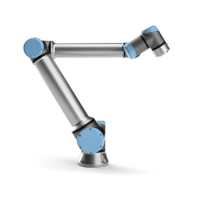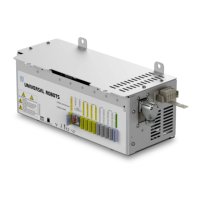Configuring a
Screwdriver
In any output Program Selection list under Output, you can select an integer output to
switch Program Selection to a number field.
1. In the Header, tap Installation.
2. Under General, select Screwdriving, or create your own TCP for screwdriving by
tapping TCP under General.
3. Under Input and Output, configure the I/Os for your screwdriver. You can use
the Interface list to filter the type of I/Os displayed under Input and Output.
4. Under Start, select the I/O that starts the screwdriving action.
Configuring the
Screwdriver
Position
1. Under Screwdriving Setup, use the drop-down menu to select a previously
defined TCP (see 20.1 TCP Configurationon page278) where Position and
Orientation are set up as follows:
•
Configure the Position to be the tip of the screwdriver tool where it
contacts the screw.
•
Configure the Orientation so that the positive Z direction is aligned to the
length of the screws to be tightened.
You can visualize the X, Y and Z coordinates of the selected TCP to confirm it matches
the tool’s bit or socket.
The Screwdriving program node uses the positive Z direction of the selected TCP to
follow the screw and calculate distances.
Configuring the
Screwdriver
Interface
1. Use the Interface drop-down menu at the top of the screen to change the
displayed content based on signal type.
2. Under Input, configure the signals that the robot receives from the screwdriver:
•
OK: High when tightening ends successfully, if not selected this condition
is not available in the Screwdriving program node
•
Not OK: High when tightening ends with errors, if not selected this
condition is not available in the Screwdriving program node
•
Ready: High when the screwdriver is ready to be started, if not selected
this condition is not checked
3. Under Output configure the signals that the robot sends to the screwdriver:
•
Start: starts the tool tightening or loosening a screw depending only on
wiring.
•
Program Selection: one integer, or up to four binary signals, can be
selected to activate different tightening configurations stored in the
screwdriver
•
Program Selection Delay: wait time to be used after changing the
screwdriver’s program to make sure it is active
Typical
Orientation
values
Values (in Rotation Vector [rad] notation) are illustrated in the following table.
User Manual 297 UR10e
Copyright © 2009–2024 by UniversalRobotsA/S. All rights reserved.

